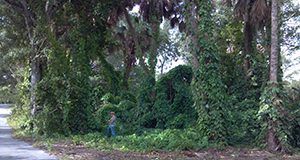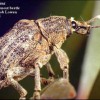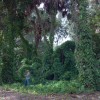
La batata aérea (Dioscorea bulbifera) es una enredadera herbácea y perenne que puede alcanzar longitudes de 20 metros o más, permitiéndole cubrir y ahogar a la vegetación nativa. En 1999, la batata aérea fue reconocida como un transformador de comunidades de plantas por el desplazamiento de especies nativas, cambios en la estructura de las comunidades y alteración de funciones ecológicas.
This is the Spanish language version of Classical Biological Control of Air Potato in Florida. Written by T. D. Center, W. A. Overholt, E. Rohrig and M. Rayamajhi and published by the UF Department of Entomology and Nematology, May 2016.
http://edis.ifas.ufl.edu/in1132
Tag: T. D. Center
Picudo de la melaleuca (nombre comun sugerido) Oxyops vitiosa (Pascoe) (Insecta: Coleoptera: Curculionidae)
 El árbol melaleuca es una planta leñosa invasiva, nativa de Australia, Nueva Guinea, y las Islas Salomón. La melaleuca, conocida también como el árbol de corteza de papel, cajeput, punk tree, o árbol de cepillo blanco, fue introducida en Florida al final del siglo 19 pero aparentemente no se naturalizó hasta el año 1906. La melaleuca fue sembrada extensivamente como un árbol ornamental, y eventualmente invadió los humedales con y sin bosques en el sur de Florida formando monocultivos densos. This 5-page fact sheet is the Spanish language version of Melaleuca Snout Beetle, Melaleuca Weevil (unofficial common names), Oxyops vitiosa (Pascoe) (Insecta: Coleoptera: Curculionidae), written by J.P. Cuda, S.A. Wineriter, G.R. Buckingham, T.D. Center, and K.T. Gioeli, and published by the UF Department of Entomology and Nematology, December 2014.
El árbol melaleuca es una planta leñosa invasiva, nativa de Australia, Nueva Guinea, y las Islas Salomón. La melaleuca, conocida también como el árbol de corteza de papel, cajeput, punk tree, o árbol de cepillo blanco, fue introducida en Florida al final del siglo 19 pero aparentemente no se naturalizó hasta el año 1906. La melaleuca fue sembrada extensivamente como un árbol ornamental, y eventualmente invadió los humedales con y sin bosques en el sur de Florida formando monocultivos densos. This 5-page fact sheet is the Spanish language version of Melaleuca Snout Beetle, Melaleuca Weevil (unofficial common names), Oxyops vitiosa (Pascoe) (Insecta: Coleoptera: Curculionidae), written by J.P. Cuda, S.A. Wineriter, G.R. Buckingham, T.D. Center, and K.T. Gioeli, and published by the UF Department of Entomology and Nematology, December 2014.
http://edis.ifas.ufl.edu/in1020
Classical Biological Control of Air Potato in Florida (ENY864/IN957)
 Air potato was introduced to Florida in 1905. By the 1980s, its vines were growing in thickets, waste areas, and hedges or fencerows in many parts of south and central Florida. By 1999, it was recognized as transforming plant communities by displacing native species, changing community structure and disrupting ecological functions. The air potato leaf beetle is a rather large, orange-red Asian leaf beetle. It feeds and develops only on air potato. The USDA-ARS Invasive Plant laboratory in Fort Lauderdale acquired this beetle from China and has begun an ambitious release program aimed at controlling air potato. This 3-page fact sheet was written by T. D. Center and W. A. Overholt, and published by the UF Department of Entomology and Nematology, October 2012.
Air potato was introduced to Florida in 1905. By the 1980s, its vines were growing in thickets, waste areas, and hedges or fencerows in many parts of south and central Florida. By 1999, it was recognized as transforming plant communities by displacing native species, changing community structure and disrupting ecological functions. The air potato leaf beetle is a rather large, orange-red Asian leaf beetle. It feeds and develops only on air potato. The USDA-ARS Invasive Plant laboratory in Fort Lauderdale acquired this beetle from China and has begun an ambitious release program aimed at controlling air potato. This 3-page fact sheet was written by T. D. Center and W. A. Overholt, and published by the UF Department of Entomology and Nematology, October 2012.
http://edis.ifas.ufl.edu/in957